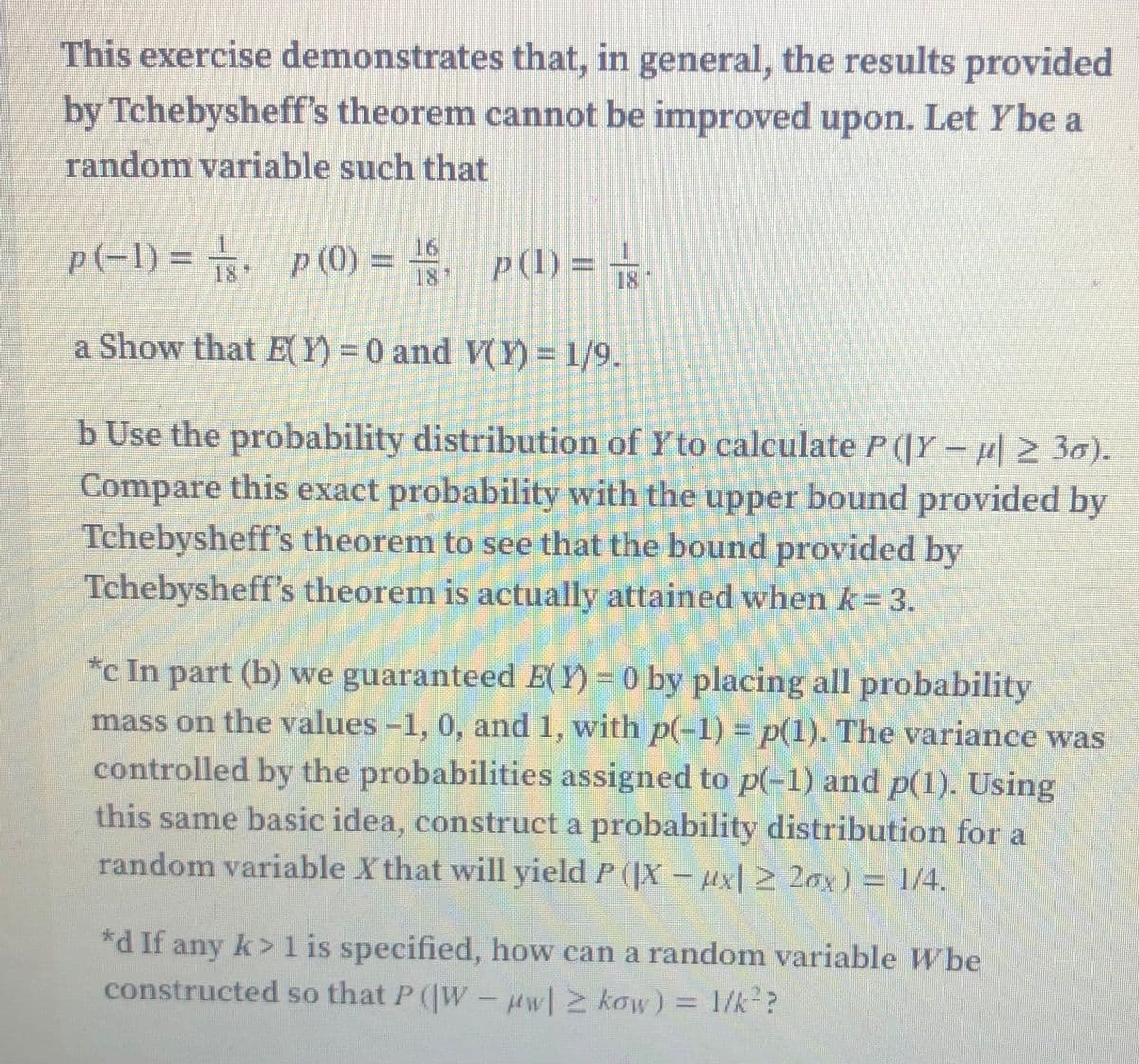This exercise demonstrates that, in general, the results provided by Tchebysheff's theorem cannot be improved upon. Let Ybe a random variable such that p(-1) = . p(1) = . p (0) = %3D a Show that E(Y) = 0 and V(Y) = 1/9. b Use the probability distribution of Yto calculate P (|Y – µ| 30). Compare this exact probability with the upper bound provided by Tchebysheff's theorem to see that the bound provided by Tchebysheff's theorem is actually attained when k= 3. *c In part (b) we guaranteed E(Y) = 0 by placing all probability mass on the values -1, 0, and 1, with p(-1)% 3 p(1). The variance was controlled by the probabilities assigned to p(-1) and p(1). Using this same basic idea, construct a probability distribution for a random variable X that will yield P (X- ux|2 2ox) = 1/4. f any k>1 is specified, how can a random variable Wbe constructed so that P (W-HwlZ kow) = 1/k2?
This exercise demonstrates that, in general, the results provided by Tchebysheff's theorem cannot be improved upon. Let Ybe a random variable such that p(-1) = . p(1) = . p (0) = %3D a Show that E(Y) = 0 and V(Y) = 1/9. b Use the probability distribution of Yto calculate P (|Y – µ| 30). Compare this exact probability with the upper bound provided by Tchebysheff's theorem to see that the bound provided by Tchebysheff's theorem is actually attained when k= 3. *c In part (b) we guaranteed E(Y) = 0 by placing all probability mass on the values -1, 0, and 1, with p(-1)% 3 p(1). The variance was controlled by the probabilities assigned to p(-1) and p(1). Using this same basic idea, construct a probability distribution for a random variable X that will yield P (X- ux|2 2ox) = 1/4. f any k>1 is specified, how can a random variable Wbe constructed so that P (W-HwlZ kow) = 1/k2?
Algebra and Trigonometry (MindTap Course List)
4th Edition
ISBN:9781305071742
Author:James Stewart, Lothar Redlin, Saleem Watson
Publisher:James Stewart, Lothar Redlin, Saleem Watson
Chapter14: Counting And Probability
Section14.2: Probability
Problem 3E: The conditional probability of E given that F occurs is P(EF)=___________. So in rolling a die the...
Related questions
Topic Video
Question
100%
c and d please!

Transcribed Image Text:This exercise demonstrates that, in general, the results provided
by Tchebysheff's theorem cannot be improved upon. Let Ybe a
random variable such that
p(-1) = –, p (0) = º, p(1) ==
18 P(1) =
18
a Show that E(Y) = 0 and V(Y) = 1/9.
b Use the probability distribution of Yto calculate P (|Y – el2 30).
Compare this exact probability with the upper bound provided by
Tchebysheff's theorem to see that the bound provided by
Tchebysheff's theorem is actually attained when k 3.
*c In part (b) we guaranteed E(Y) = 0 by placing all probability
mass on the values -1, 0, and 1, with p(-1) = p(1). The variance was
controlled by the probabilities assigned to p(-1) and p(1). Using
this same basic idea, construct a probability distribution for a
random variable X that will yield P (X- ux| 2ox) = 1/4.
*d If any k> 1 is specified, how can a random variable Wbe
constructed so that P (W - wl2 kow) = 1/k-?
Expert Solution
This question has been solved!
Explore an expertly crafted, step-by-step solution for a thorough understanding of key concepts.
This is a popular solution!
Trending now
This is a popular solution!
Step by step
Solved in 2 steps

Knowledge Booster
Learn more about
Need a deep-dive on the concept behind this application? Look no further. Learn more about this topic, probability and related others by exploring similar questions and additional content below.Recommended textbooks for you

Algebra and Trigonometry (MindTap Course List)
Algebra
ISBN:
9781305071742
Author:
James Stewart, Lothar Redlin, Saleem Watson
Publisher:
Cengage Learning

Algebra and Trigonometry (MindTap Course List)
Algebra
ISBN:
9781305071742
Author:
James Stewart, Lothar Redlin, Saleem Watson
Publisher:
Cengage Learning